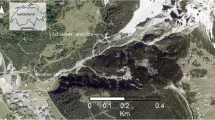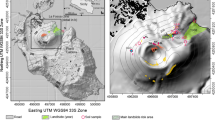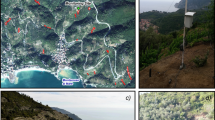Abstract
A study of factors impacting landslide displacement rates was conducted on the Ripley Landslide within the Thompson River valley in British Columbia, Canada for the International Programme on Landslides’ project #202. Seasonal and multiyear changes in atmospheric factors cause cyclic fluctuation of matric suction in the vadose zone through changes to the in situ water content. The ingress of moisture is shown to contribute to multiyear and seasonal loss of stability causing increasing landslide displacement rates, often disregarded in slope stability calculations. However, the water content in the unsaturated zone is important, especially in semi-arid to arid climates where the water table is low and large portions of the slope are unsaturated. Additional tools for studying long-term variations in climate and seasonal changes in water content are presented. These tools are used to characterize historical climate and compare several factors that have resulted in changing landslide displacement rates and magnitude. Infiltration of precipitation and snowmelt directly contributes to matric suction loss in the head scarp and is exacerbated by the presence of tension cracks. While groundwater levels are often correlated to changing displacement rates, changes in matric suction can also influence the rates of displacement. Climatic trends over subsequent years alter the long-term soil water accumulation which impacts rates of landslide displacement. By accounting for additional strength, or potentially a loss in strength due to increasing water content, it is possible to develop a more complete understanding of the mechanisms of climate change which drive displacement rates in the translational, metastable earthen slides that dominate the Thompson River valley. These mechanisms can be applied to comparable river valleys around the world.















Similar content being viewed by others
References
Allen RG (1996) Assessing integrity of weather data for reference evapotranspiration estimate. J Irrig Drain Eng 122(2):97–106
Allen RG, Pereira LS, Raes D, Smith M (1998) Crop evapotranspiration–guidelines for computing crop water requirements–FAO irrigation and drainage paper 56. Food and Agriculture Organization, Rome
Allen RG, Trezza R, Tasumi M (2006) Analytical integrated function for daily solar radiation on slopes. Agric Forest Meteorol 139:55–73
American Society of Civil Engineers (2005) The ASCE standardized reference evapotranspiration equation. ASCE-EWRI Task Committee Report
Bishop AW (1959) The principle of effective stress. Teknisk Ukeblad 106(39):859–863
Bishop NF (2008) Geotechnics and hydrology of landslides in Thompson River Valley, near Ashcroft, British Columbia. MSc thesis, University of Waterloo, Waterloo, Canada
Blight GE (2003) The vadose zone soil-water balance and transpiration rates of vegetation. Géotechnique 53(1):55–64
Bobrowsky P, Huntley D, Neelands P, MacLeod R, Mariampillai D, Hendry MT, Macciotta R, Reeves H, Chambers J (2017) Ripley Landslide–Canada’s premier landslide field laboratory. In: Proceedings Volume of the Geological Society of America Annual Meeting, Seattle, p 1
Brooks RH, Corey AT (1964) Hydraulic properties of porous medium. Colorado State University (Fort Collins), hydrology paper no. 3, March 1964
Bunce CM (2008) Risk estimation for trains exposed to landslides. PhD thesis, University of Alberta, Edmonton, Canada
Campbell GS (1988) Soil water potential measurement: an overview. Irrig Sci 9(4):265–273
Christiansen EA, Sauer EK (1984) Landslide styles in the Saskatchewan River plain: a geological appraisal. In: Proceedings of 37th Canadian Geotechnical Conference, Toronto, Canada. pp 35-48
Clague JJ, Evans SG (2003) Geological framework of large historic landslides in Thompson River Valley, British Columbia. Environ Eng Geosci 9(3):201–212
Clark I, Fritz P (1997) Environmental isotopes in hydrogeology. CRC Press/Lewis Publishers, Boca Raton
Craig H (1961) Isotopic variations in meteoric waters. Science 133:1702–1703
Environment Canada (2020) Historical climate data. Available from: climate.weather.gc.ca (accessed May 2020)
Eshraghian A, Martin CD, Cruden DM (2007) Complex earth slides in the Thompson River Valley, Ashcroft, British Columbia. Environ Eng Geosci 13(2):161–181
Eshraghian A, Martin CD, Morgenstern NR (2008) Movement triggers and mechanisms of two earth slides in the Thompson River Valley, Ashcroft, British Columbia, Canada. Can Geotech J 45(9):1189–1209
Fish Protection Act (1997) Province of British Columbia–Ministry of Environment, Land and Parks. Bill 25, 2nd Session, 36th Parliament. Victoria, Canada
Fredlund DG, Rahardjo H (1993) Soil mechanics for unsaturated soils. Wiley, New York
Fredlund DG, Xing A (1994) Equations for the soil-water characteristic curve. Can Geotech J 31(4):521–532
Fredlund DG, Morgenstern NR, Widger RA (1978) The shear strength of unsaturated soils. Can Geotech J 15(3):313–321
Fredlund DG, Xing A, Huang S (1994) Predicting the permeability function for unsaturated soils using the soil-water characteristic curve. Can Geotech J 31(4):533–546
Fredlund DG, Rahardjo H, Fredlund MD (2012) Unsaturated soil mechanics in engineering practice. Wiley, Hoboken
Geoslope International Ltd (2019) GeoStudio 2019 R2 Version 10.1. Available from: geoslope.com
Guan Y (1996) The measurement of soil suction. PhD thesis, University of Saskatchewan, Saskatoon, Canada
Gunn D, Chambers J, Uhlemann S, Wilkinson P, Meldrum P, Dijkstra T, Haslam E, Kirkham M, Wragg J, Holyoake S, Hughes P, Hen-Jones R, Glendinning S (2015) Moisture monitoring in clay embankments using electrical resistivity tomography. Constr Build Mater 92:82–94
Hage KD, Gray J, Linton JC (1975) Isotopes in precipitation in northwestern North America. Mon Weather Rev 103:958–966
Hargreaves GH, Samani ZA (1985) Reference crop evapotranspiration from temperature. Appl Eng Agric 1(2):96–99
Haug MD, Sauer EK, Fredlund DG (1977) Retrogressive slope failure at Beaver Creek, south of Saskatoon, Saskatchewan, Canada. Can Geotech J 14(3):288–301
Hendry MT, Martin CD, Choi E, Edwards T, Chadwick I (2013) Safe train operations over a moving landslide. In: Proceedings of the 10th World Conference on Railway Research, Sydney, Australia
Hendry MT, Macciotta R, Martin CD, Reich B (2015a) Effect of Thompson River elevation on velocity and instability of Ripley Slide. Can Geotech J 52(3):257–267
Hendry MJ, Schmeling E, Wassenaar LI, Barbour SL, Pratt D (2015b) Determining the stable isotope composition of pore water from saturated and unsaturated zone core: improvements to the direct vapour equilibration laser spectrometry method. Hydrol Earth Syst Sci 19:4427–4440
Hendry MT, Smith LA, Hendry MJ (2018) Analysis of the measured pore pressure response to atmospheric pressure changes to evaluate small strain moduli: methodology and case studies. Can Geotech J 55(9):1248–1256
Holmes J, Chambers J, Donohue S, Huntley D, Bobrowsky P, Meldrum P, Uhlemann S, Wilkinson P, Swift R (2018) The use of near surface geophysical methods for assessing the condition of transport infrastructure. Civil Engineering Research in Ireland 2018 (CERI2018), Dublin, 6 p
Holmes J, Chambers J, Meldrum P, Wilkinson P, Boyd J, Williamson P, Huntley D, Sattler K, Elwood D, Sivakumar V, Reeves H, Donohue S (2020) Four-dimensional electrical resistivity tomography for continuous, near-real-time monitoring of a landslide affecting transport infrastructure in British Columbia, Canada. Near Surf Geophys 18:337–351
Huntley D, Bobrowsky P, Hendry MT, Macciotta R, Best M (2019a) Multi-technique geophysical investigation of a very slow-moving landslide near Ashcroft, British Columbia, Canada. J Environ Eng Geophys 24(1):87–110
Huntley D, Bobrowsky P, Hendry MT, Macciotta R, Elwood D, Sattler K, Best M, Chambers J, Meldrum P (2019b) Application of multi-dimensional electrical resistivity tomography datasets to investigate a very slow-moving landslide near Ashcroft, British Columbia, Canada. Landslides 16(5):1033–1042
Huntley D, Bobrowsky P, Sattler K, Elwood D, Holmes J, Chambers J, Meldrum P, Wilkinson P, Hendry MT, Macciotta R (2020) Hydrogeological and geophysical properties of the very slow-moving Ripley Landslide, Thompson River valley, British Columbia. Can J Earth Sci in press
Hutchinson JN (1995) Keynote paper: landslide hazard assessment. In: Proceedings of 6th International Symposium on Landslides, Christchurch, New Zealand. 3:1805-1841
Jarvis PG (1976) The interpretation of the variations in leaf water potential and stomatal conductance found in canopies in the field. Philos Trans R Soc Lond 273:593–610
Journault J, Macciotta R, Hendry MT, Charbonneau F, Huntley D, Bobrowsky P (2017) Measuring the activity of the Thompson River Valley landslides, south of Ashcroft, BC, Canada, using satellite InSAR. Landslides 15(4):621–636
Klassen RW (1972) Wisconsin events and the Assiniboine and Qu’Appelle Valleys of Manitoba and Saskatchewan. Can J Earth Sci 9(5):544–560
Leong E, Rahardjo H (1997) Permeability functions for unsaturated soils. J Geotech Geoenviron 123(12):1118–1126
Leroueil S (1999) Natural slopes and cuts: movement and failure mechanisms. Géotechnique 51(3):197–243
Macciotta R, Hendry MT, Martin CD, Elwood D, Lan H, Huntley D, Bobrowsky P, Sladen W, Bunce C, Choi E, Edwards T (2014) Monitoring of the Ripley Landslide in the Thompson River Valley, BC. In: Proceedings and Abstracts Volume Geohazards 6 Symposium, Kingston, Canada. 8 p
Macciotta R, Hendry MT, Martin CD (2016) Developing an early warning system for a very slow landslide based on displacement monitoring. Nat Hazards 81(2):887–907
Martin RL, Williams DR, Balanko LA, Morgenstern NR (1984) The Grierson Hill slide, Edmonton, Alberta. In: Proceedings of the 37th Canadian Geotechnical Conference: Canadian case histories - landslides, Toronto, Canada. pp 125-133
Meter Group (2019) Teros 21 manual. URL: http://publications.metergroup.com/Manuals/20428_TEROS21_Manual_Web.pdf [Last accessed: Jan 15, 2020]
Mollard JD (1986) Early regional photointerpretation and geological studies of landslide terrain along the South Saskatchewan and Qu’Appelle River Valleys. Can Geotech J 23(1):79–83
Monteith JL (1965) Evaporation and environment. Symp Soc Exp Biol 19:205–234
Mualem Y (1976) A new model for predicting the hydraulic conductivity of unsaturated porous media. Water Resour Res 12(3):513–522
Pennell DG (1969) Residual strength analysis of five landslides. PhD thesis, University of Alberta, Edmonton, Canada
Rahardjo H, Leong EC (2006) Suction measurements. In: Proceedings of 4th International Conference on Unsaturated Soils, Carefree, USA. Unsaturated Soils. Geotechnical Special Publication 147. Miller GA, Zapata CE, Houston SL, Fredlund DG (eds). ASCE, 1: 81-104
Ridley AM, Wray WK (1996) Suction measurement: a review of current theory and practice. In: Proceedings Volume 3 of 1st International Conference on Unsaturated Soils, Paris, France. pp 1293-1322
Ridley A, McGinnity B, Vaughan P (2004) Role of pore water pressures in embankment stability. Proc Inst Civ Eng 157(4):193–198
Rozanski K, Araguas-Araguas L, Gonfiantini R (1993) Isotopic patterns in modern global precipitation. Geophysical Monograph 78. American Geophysical Union, Washington DC, USA, pp 1–36
Ryder JM, Fulton RJ, Clague JJ (1991) The Cordilleran ice sheet and the glacial geomorphology of southern and central British Columbia. Géog Phys Quatern 45(3):365–377
Sassa K (2019) The Kyoto Landslide Commitment 2020: first signatories. Landslides 16:2053–2057
Sattler K, Elwood D, Hendry MT, Macciotta R, Huntley D, Bobrowsky P, Meldrum P (2018) Real-time monitoring of soil water content and suction within a slow moving landslide. In: Proceedings of 71st Canadian Geotechnical Conference, Edmonton, Canada. 8 p
Sattler K, Elwood D, Hendry MT, Huntley D (2019) Additional tools for the study of variable water content effects on a slow-moving landslide. In: Proceedings of 72nd Canadian Geotechnical Conference, St. John’s, Canada. 8 p
Schafer MB (2016) Kinematics and controlling mechanisms of the slow-moving Ripley landslide. MSc thesis, University of Alberta, Edmonton, Canada
Siemens G (2018) Thirty-ninth Canadian geotechnical colloquium: unsaturated soil mechanics–bridging the gap between research and practice. Can Geotech J 55(7):909–927
Smethurst J, Clarke D, Powrie W (2012) Factors controlling the seasonal variation in soil water content and pore water pressures within a lightly vegetated clay slope. Géotechnique 62(5):429–446
Stanton RB (1898) The great land-slides on the Canadian Pacific Railway in British Columbia. In: Proceedings of the Institution of Civil Engineers, Session 1897-1898, Part II, Section 1, pp 1-46
Stewart JB (1988) Modelling surface conductance of pine forest. Agric For Meteorol 43(1):19–35
Tarantino A, Ridley AM, Toll DG (2008) Field measurement of suction, water content, and water permeability. Geotech Geol Eng 26(6):751–782
van Genuchten MT (1980) A closed-form equation for predicting the hydraulic conductivity of unsaturated soils. Soil Sci Soc Am J 44(5):892–898
Wassenaar LI, Hendry MJ, Chostner VL, Lis GP (2008) High resolution pore water δ2H and δ18O measurements by H2O(liquid)-H2O(vapour) equilibration laser spectroscopy. Environ Sci Technol 42(24):9262–9267
Yoshida RT, Krahn J (1984) Movement and stability analysis of the Beaver Creek landslide. In: Proceedings of 37th Canadian Geotechnical Conference: Canadian case histories - landslides, Toronto, Canada. pp 223-231
Acknowledgements
Access to the Ripley Landslide for the research programme was graciously provided to the authors by CP and CN. Installation and monitoring of these instruments would not be possible without their ongoing support. Productive collaboration and data sharing with the Geological Survey of Canada and the British Geological Survey have been greatly appreciated as we work towards the common goal of protecting railway infrastructure. Holmes, Wilkinson, Chambers and Meldrum publish with permission of the Executive Director of the BGS (UKRI).
Funding
The authors received continued financial support and resources from Transport Canada (TC), the (Canadian) Railway Ground Hazard Research Program (RGHRP), the Canadian Rail Research Laboratory (CaRRL) and Clifton Engineering Group. These entities are supported by the Natural Sciences and Engineering Research Council of Canada (NSERC), CP and CN.
Author information
Authors and Affiliations
Corresponding author
Rights and permissions
About this article
Cite this article
Sattler, K., Elwood, D., Hendry, M.T. et al. Quantifying the contribution of matric suction on changes in stability and displacement rate of a translational landslide in glaciolacustrine clay. Landslides 18, 1675–1689 (2021). https://doi.org/10.1007/s10346-020-01611-3
Received:
Accepted:
Published:
Issue Date:
DOI: https://doi.org/10.1007/s10346-020-01611-3




